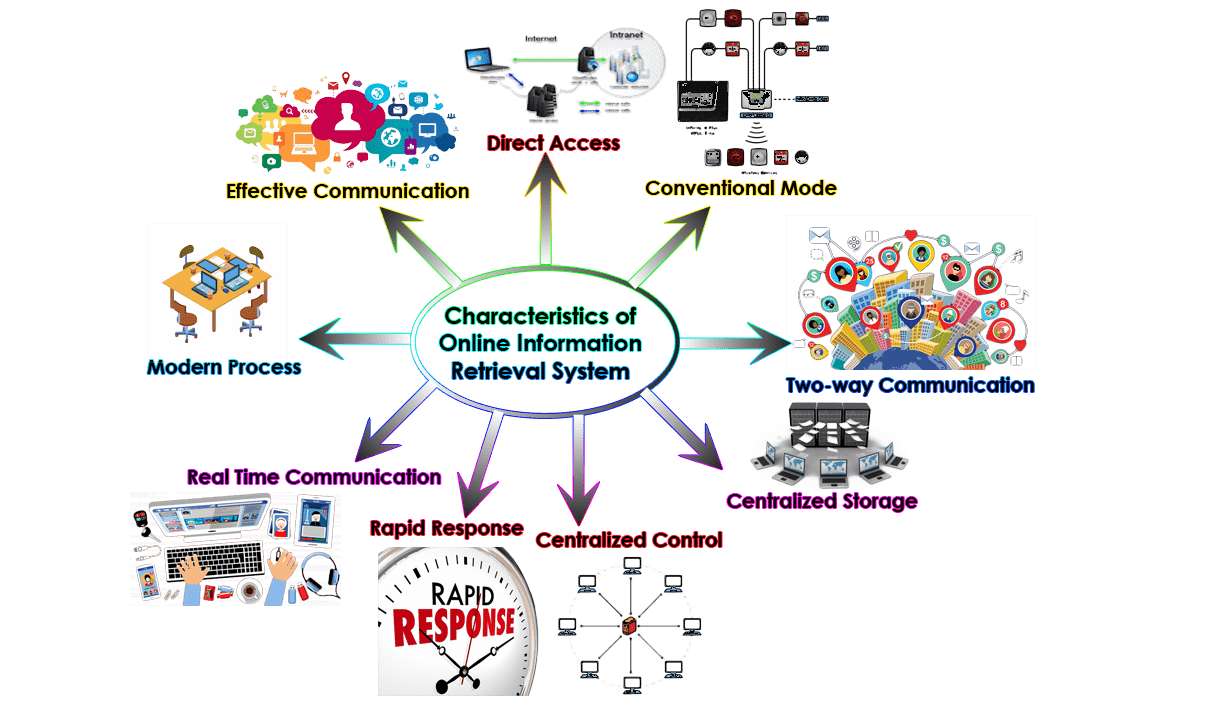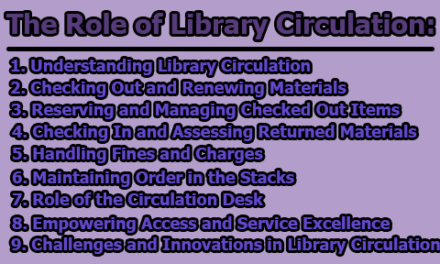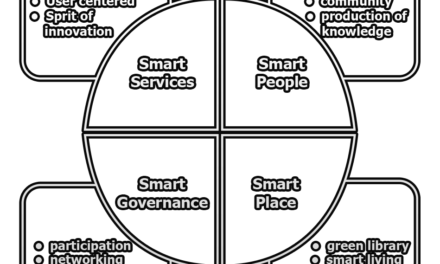Reasons and Importance of Library Cooperation and Resource Sharing:
Library cooperation and resource sharing are crucial practices in the library and information science field, offering numerous reasons and significant importance for libraries, their patrons, and society as a whole. In this article, we will explore the reasons and importance of library cooperation and resource sharing.
Reasons for Library Cooperation:
Library cooperation is driven by a multitude of reasons, each rooted in the desire to improve library services, enhance access to information, and adapt to evolving user needs. The following sections outline some of the key reasons for library cooperation.
1. Resource Sharing: One of the most prominent reasons for library cooperation is resource sharing. Libraries often have limited budgets and physical space constraints. Through cooperation, they can share their collections with other libraries, thus increasing the variety and quantity of resources available to their patrons. This not only benefits the libraries themselves but also enhances the quality of service offered to users.
Example: In a study conducted by the American Library Association (ALA), it was found that interlibrary loan and resource sharing services significantly improved patron satisfaction with library services (ALCTS, 2019).
2. Cost Efficiency: In an era of tight budgets and financial constraints, library cooperation provides an avenue for cost savings. By pooling resources and sharing the expenses associated with collection development, cataloging, and technology infrastructure, libraries can optimize their use of funds while still offering a robust collection and services.
Example: The OhioLINK consortium, which comprises academic libraries in Ohio, saved an estimated $27 million annually through collaborative collection development and resource sharing (OhioLINK, 2021).
3. Access to Specialized Collections: Libraries often have unique and specialized collections that are of interest to a limited audience. Through cooperation, libraries can ensure that these collections are accessible to researchers and enthusiasts who may not have access to such materials otherwise.
Example: The Consortium of European Research Libraries (CERL) facilitates access to rare books and manuscripts across Europe, enabling scholars to access valuable resources held in multiple libraries (CERL, n.d.).
4. Expanded Services: Cooperation allows libraries to expand their range of services. For instance, a smaller public library can provide access to academic journals and research databases through cooperation with a nearby university library. This broadens the scope of services available to the community.
Example: The Massachusetts Library System’s Commonwealth eBook Collections program enables public libraries in the state to offer a wide range of digital resources, including e-books and audiobooks, to their patrons (Massachusetts Library System, 2021).
5. Digital Transformation: In the digital age, libraries are faced with the challenge of managing and providing access to an ever-growing volume of electronic resources. Cooperative efforts in digitization, digital preservation, and online resource sharing are crucial for libraries to navigate the complexities of digital transformation.
Example: The Digital Public Library of America (DPLA) brings together digital content from libraries, archives, and museums across the United States, creating a unified platform for users to access a wealth of digital resources (Digital Public Library of America, n.d.).
6. Expertise and Knowledge Sharing: Libraries can benefit from sharing expertise and best practices. Collaboration allows librarians to exchange ideas, learn from one another, and stay current with emerging trends and technologies in the field.
Example: The International Federation of Library Associations and Institutions (IFLA) hosts conferences, workshops, and webinars where librarians from around the world can share their experiences and expertise (IFLA, n.d.).
7. Community Engagement: Library cooperation can strengthen community engagement efforts. When libraries work together, they can organize joint programs, events, and outreach activities that have a more significant impact on their communities.
Example: The Urban Libraries Council (ULC) in the United States facilitates collaborative initiatives among urban libraries to address common challenges and enhance community engagement (Urban Libraries Council, n.d.).
Importance of Library Cooperation:
Having discussed the reasons behind library cooperation, it is essential to delve into the multifaceted importance of this collaborative approach in the modern information landscape.
1. Enhanced Access to Information: Library cooperation significantly improves access to information. Patrons benefit from a wider array of resources and materials, including books, journals, digital media, and specialized collections. This access fosters learning, research, and personal enrichment.
Example: A study by McCook (2008) highlights how library cooperation in public libraries can bridge the digital divide by providing access to digital resources and technology for underserved communities.
2. Support for Research and Scholarship: Academic libraries often collaborate through consortia to provide seamless access to research materials for scholars and students. This support is vital for the advancement of research and the dissemination of knowledge.
Example: The Big Ten Academic Alliance, consisting of universities in the United States, collaboratively provides access to a vast collection of research materials, bolstering research efforts across member institutions (Big Ten Academic Alliance, 2021).
3. Preservation of Cultural Heritage: Libraries, archives, and cultural institutions cooperate to preserve and digitize cultural heritage materials. This collaborative preservation effort ensures that rare and valuable artifacts are safeguarded for future generations.
Example: The British Library’s Endangered Archives Programme collaborates with institutions worldwide to digitize and preserve endangered archival materials from diverse cultures (British Library, n.d.).
4. Efficiency in Collection Development: Libraries can strategically build their collections by collaborating on collection development. This ensures that resources are acquired based on the needs and interests of the user community, leading to more efficient allocation of resources.
Example: The Colorado Alliance of Research Libraries collaboratively manages a shared print repository, allowing member libraries to reduce duplicate holdings and optimize collection budgets (Colorado Alliance of Research Libraries, n.d.).
5. Global Collaboration: In an increasingly interconnected world, library cooperation transcends geographical boundaries. Libraries worldwide collaborate to share resources, knowledge, and cultural perspectives, promoting global understanding and cooperation.
Example: The International Interlibrary Loan (ILL) service, provided by institutions like the Library of Congress, facilitates resource sharing among libraries across the globe, supporting cross-cultural research and information exchange (Library of Congress, n.d.).
6. Adaptation to Technological Changes: Library cooperation is instrumental in adapting to rapid technological changes. Collaborative efforts in digitization, metadata standards, and technology infrastructure development ensure that libraries remain relevant in the digital age.
Example: The Europeana initiative brings together cultural heritage organizations to create a digital platform that provides access to millions of cultural artifacts from across Europe (Europeana, n.d.).
7. Strengthening Information Literacy: Libraries can cooperate to enhance information literacy programs. Collaborative initiatives can include developing online tutorials, workshops, and educational resources that empower users to navigate the information landscape effectively.
Example: The Library Information Literacy Assessment Database (LILAD) is a collaborative project that compiles and shares information literacy assessment tools and resources used by libraries worldwide (LILAD, n.d.).
8. Resilience in Times of Crisis: Library cooperation is crucial during times of crisis, such as natural disasters or public health emergencies. Libraries can support one another by sharing resources, providing emergency services, and ensuring continued access to information.
Example: The Libraries Respond initiative, led by the American Library Association (ALA), showcases examples of libraries coming together to support their communities during crises (ALA, n.d.).
9. Advocacy and Influence: Collaborative efforts allow libraries to have a stronger collective voice in advocating for policy changes, funding, and support at local, national, and international levels. This can help shape policies that benefit libraries and their users.
Example: The Coalition for Networked Information (CNI) advocates for libraries and information technology by facilitating collaborative discussions among academic institutions and organizations (CNI, n.d.).
10. Community-Centered Services: Library cooperation fosters community-centered library services. When libraries collaborate, they can tailor their offerings to meet the diverse needs and pExamples of their communities, creating a more inclusive and responsive environment.
Example: The Anythink Libraries in Colorado collaboratively design their services with community input, resulting in innovative programs and spaces that reflect the needs of their users (Anythink Libraries, n.d.).
Reasons for Library Resource Sharing:
1. Optimizing Limited Resources: Libraries, especially smaller ones with limited budgets and space, may find it challenging to maintain comprehensive collections. Through resource sharing, they can access materials that would otherwise be cost-prohibitive or unavailable to their patrons. This optimization of resources ensures that users have a broader range of materials at their disposal.
Example: In a study conducted by the Colorado Alliance of Research Libraries, it was found that resource sharing helped member libraries significantly reduce duplicate holdings and optimize their collections, leading to cost savings and improved access to materials (Colorado Alliance of Research Libraries, n.d.).
2. Access to Specialized Materials: Libraries often face patron requests for specialized or niche materials that may not justify their inclusion in a permanent collection. Resource sharing allows libraries to fulfill these requests by borrowing materials from other institutions. This ensures that patrons have access to a wide array of subject-specific resources.
Example: The Consortium of European Research Libraries (CERL) facilitates access to rare books and manuscripts across Europe, enabling scholars to access valuable resources held in multiple libraries (CERL, n.d.).
3. Supporting Lifelong Learning: Public libraries play a crucial role in supporting lifelong learning. By participating in resource sharing networks, they can provide patrons with access to an extensive collection of materials, including books, audiovisual resources, and digital content. This promotes continuous learning and personal growth.
Example: The Massachusetts Library System’s Commonwealth eBook Collections program enables public libraries in the state to offer a wide range of digital resources, including e-books and audiobooks, to their patrons (Massachusetts Library System, 2021).
4. Enhancing Research and Scholarship: Academic and research libraries rely on resource sharing to support research and scholarship. Interlibrary loan services and cooperative agreements among libraries ensure that scholars and students have access to a wealth of scholarly materials, fostering academic excellence.
Example: The Big Ten Academic Alliance, consisting of universities in the United States, collaboratively provides access to a vast collection of research materials, bolstering research efforts across member institutions (Big Ten Academic Alliance, 2021).
5. Serving Diverse User Needs: Libraries cater to a diverse user base with varying interests and information needs. Resource sharing helps libraries offer a broader range of materials, ensuring that they can meet the diverse requirements of their patrons, from children’s literature to academic research.
Example: The OhioLINK consortium, which comprises academic libraries in Ohio, saved an estimated $27 million annually through collaborative collection development and resource sharing, benefiting students, faculty, and researchers (OhioLINK, 2021).
6. Access to Digital Resources: In the digital age, libraries are challenged with providing access to electronic resources, including e-books, databases, and online journals. Resource sharing allows libraries to share digital content licenses, providing patrons with seamless access to a wealth of online information.
Example: The Digital Public Library of America (DPLA) brings together digital content from libraries, archives, and museums across the United States, creating a unified platform for users to access a wealth of digital resources (Digital Public Library of America, n.d.).
7. Community Engagement and Outreach: Resource sharing can strengthen community engagement efforts by offering patrons access to a wider range of materials and services. Libraries can collaborate to organize joint programs, events, and outreach activities that have a more significant impact on their communities.
Example: The Urban Libraries Council (ULC) in the United States facilitates collaborative initiatives among urban libraries to address common challenges and enhance community engagement (Urban Libraries Council, n.d.).
Importance of Library Resource Sharing:
1. Cost-Efficiency: Resource sharing helps libraries make the most of their financial resources. Instead of purchasing multiple copies of the same item, libraries can borrow or share materials, reducing acquisition costs. This cost-efficiency is particularly crucial for libraries operating on tight budgets.
Example: A study conducted by the American Library Association (ALA) found that interlibrary loan and resource sharing services significantly improved patron satisfaction with library services, highlighting the cost-effective nature of these services (ALCTS, 2019).
2. Fulfilling User Expectations: In today’s information-rich world, library users expect quick and easy access to a wide range of materials. By participating in resource sharing networks, libraries can meet these expectations and provide a high level of service to their patrons.
Example: McCook (2008) discusses how resource sharing in public libraries can bridge the digital divide by providing access to digital resources and technology for underserved communities.
3. Preservation of Cultural Heritage: Resource sharing contributes to the preservation of cultural heritage. Libraries collaborate to digitize and preserve rare and valuable materials, ensuring that they are accessible to future generations.
Example: The British Library’s Endangered Archives Programme collaborates with institutions worldwide to digitize and preserve endangered archival materials from diverse cultures (British Library, n.d.).
4. Expanded Research Opportunities: Academic and research libraries benefit significantly from resource sharing. Access to materials beyond their own collections expands research opportunities for faculty and students, ultimately enhancing the quality of scholarly work.
Example: The Association of Research Libraries (ARL) underscores the importance of resource sharing in academic libraries and its role in supporting research and scholarship (ARL, 2014).
5. Support for Rural and Underserved Communities: Rural and underserved communities often have limited access to libraries with extensive collections. Resource sharing can bridge this gap by connecting these communities to larger library networks, providing access to a broader range of materials.
Example: The Collaborative Summer Library Program (CSLP) is an example of resource sharing among libraries in the United States that enhances access to summer reading programs and materials for children and teens in underserved communities (CSLP, n.d.).
6. Promoting Information Literacy: Resource sharing encourages information literacy by exposing users to various library resources and services. Users learn how to navigate different library catalogs and systems, fostering their information-seeking skills.
Example: The Library Information Literacy Assessment Database (LILAD) is a collaborative project that compiles and shares information literacy assessment tools and resources used by libraries worldwide, emphasizing the role of information literacy in resource sharing (LILAD, n.d.).
7. Access to Unique Collections: Many libraries possess unique and valuable collections that are of interest to researchers and scholars worldwide. Through resource sharing, these collections can be made accessible to a broader audience, increasing the impact of the institution.
Example: The National and University Library in Zagreb, Croatia, collaborates with libraries worldwide to digitize and provide online access to valuable cultural heritage materials, manuscripts, and rare books, demonstrating the global reach of unique collections (National and University Library in Zagreb, n.d.).
In conclusion, library cooperation and resource sharing are vital for overcoming resource limitations, providing diverse and cost-effective services, enhancing access to information, and supporting the needs of library users and the broader community. These practices are integral to the success and relevance of modern libraries.
References:
- American Library Association (ALA). (n.d.). Libraries Respond: Pandemic and COVID-19 Resources.
- Association of Research Libraries (ARL). (2012). Research Library Collaboration.
- Association of Research Libraries (ARL). (2014). Re: Thinking Resources: Library Collaboration for Research Support.
- Big Ten Academic Alliance. (2021). Big Ten Academic Alliance Libraries. https://btaa.org/
- British Library. (n.d.). Endangered Archives Programme.
- Canadian Research Knowledge Network (CRKN). (2021). Governance.
- Collaborative Librarianship. (n.d.). Collaborative Librarianship Journal. https://digitalcommons.du.edu/collaborativelibrarianship/
- Colorado Alliance of Research Libraries. (n.d.). Shared Print Repository.
- Consortium of European Research Libraries (CERL). (n.d.). About CERL. https://www.cerl.org/
- Digital Public Library of America (DPLA). (n.d.). About DPLA. https://dp.la/about
- Massachusetts Library System. (2021). Commonwealth eBook Collections.
- McCook, K. (2008). Public Libraries and the Digital Divide: What Does the National Survey Data Tell Us? Journal of Library Administration, 48(1-2), 101-127.
- National and University Library in Zagreb. (n.d.). Digital Collections.
- (n.d.). OCLC Interlibrary Loan (ILL) and Resource Sharing.
- (2021). About OhioLINK. https://www.ohiolink.edu/
- Urban Libraries Council. (n.d.). About Urban Libraries Council. https://www.urbanlibraries.org/about

Library Lecturer at Nurul Amin Degree College










